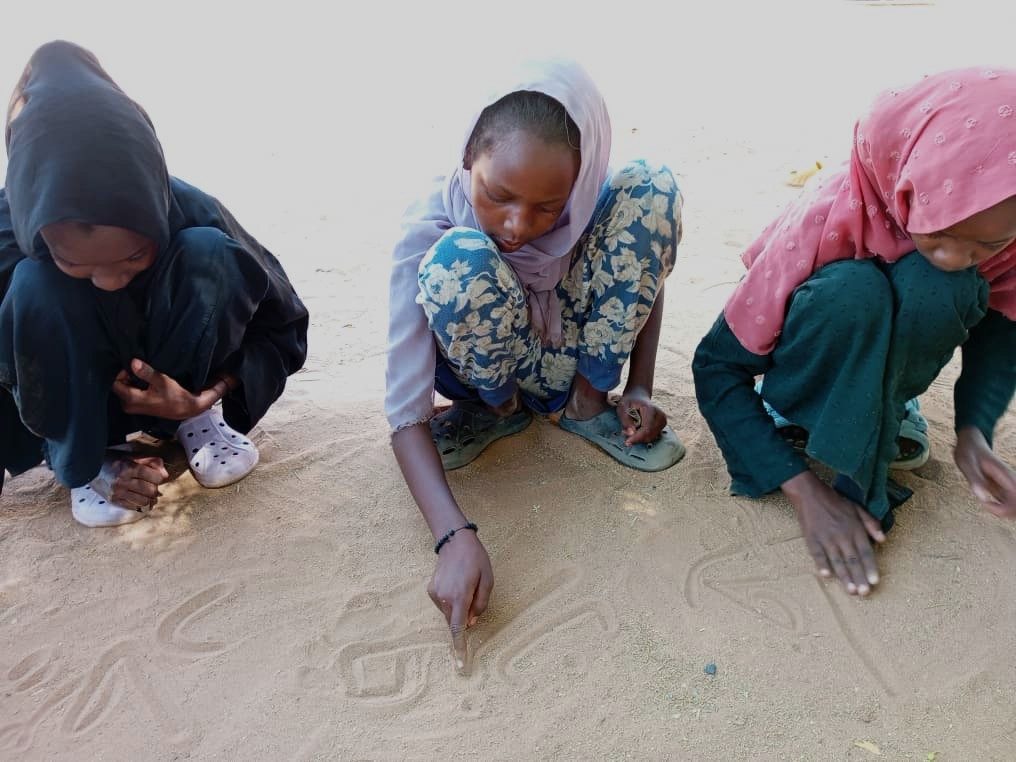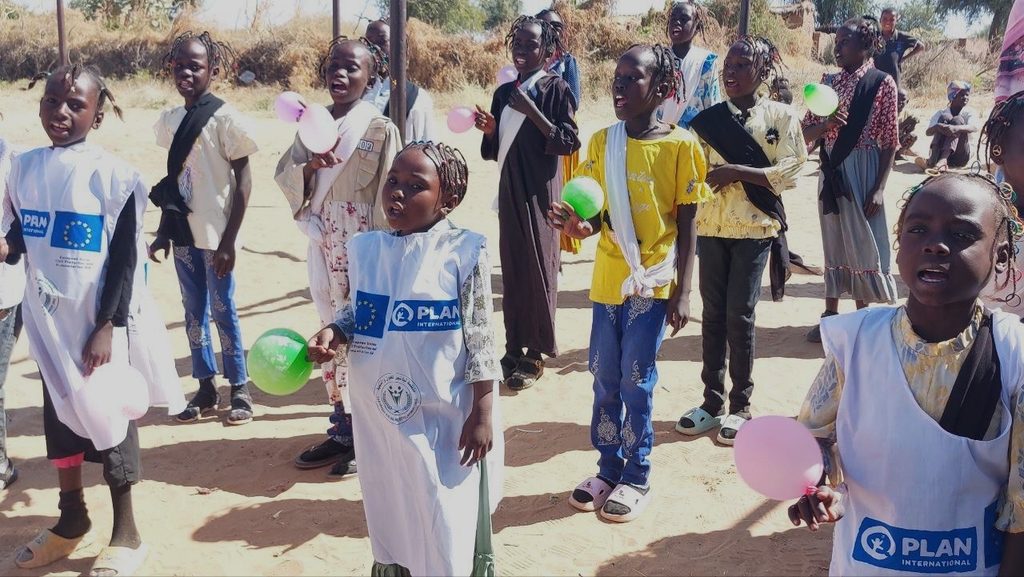The power of school: transforming children’s lives in Sudan
How education in emergencies can help alleviate suffering and save children’s lives
13 May 2025Plan International, in partnership with DG ECHO, delivers an Education in Emergencies programme specifically adapted to the needs of the community in North Darfur.

Photo credit: Three girls using sand on the ground as a writing practice tool. Copyright: Plan International. All rights reserved.
Children in Darfur: a humanitarian crisis
The conflict between the Sudanese Armed Forces and the paramilitary Rapid Support Forces has resulted in a devastating surge in violence, with the highest number of children killed, injured or subjected to other grave violations since 2006, when the United Nations started to systematically collect data in the country.
Gender-based violence (GBV) has also surged. In less than two years, the number of people at risk of GBV has more than tripled, reaching a shocking 25% of the population.
Violence is far from the only threat children face. In North Darfur, more than 457,000 children are acutely malnourished, with nearly 146,000 suffering from severe acute malnutrition. The delivery of even the most essential supplies is increasingly difficult, with roads blocked due to the volatile security situation.
The humanitarian crisis in Sudan is the largest displacement crisis in the world. In Darfur, violence displaced over 605,000 people between April 2024 and January 2025 alone. The deteriorating security situation often forces people who are already displaced to move again. This was the case, for example, when people moved from Al Fasher to isolated areas around ZamZam camp and Tawila, with limited or no access to basic services.
Threats to displaced children
Plan International Sudan relocated its education in emergencies programme from the increasingly inaccessible Zamzam camp, to gathering sites of displaced communities. Following the very first site visits by Plan Sudan, critical safety concerns for children became immediately evident.
Parents and caregivers expressed deep concerns about leaving their children unsupervised due to the heightened risk of violence and abduction. Humanitarian workers were also confronted with uncertainty, as Plan Sudan staff faced similar dangers, having to walk two hours to reach the gathering sites.
However, despite these risks, parents and caregivers were compelled to leave in order to seek work or retrieve essential items for their families, particularly amidst the ongoing malnutrition emergency in the area. Their absence caused significant stress to themselves and heightened the risk of violence against their children.

The lifesaving role of education in emergencies
Within this context, Plan Sudan, in partnership with DG ECHO, launched an Education in Emergencies (EiE) programme specifically adapted to the needs of the community. Despite other pressing humanitarian needs, such as for water and food, parents and caregivers quickly recognised the critical, lifesaving potential of the EiE initiative and actively encouraged their children to enroll in the programme.
The benefits of EiE are many and lifesaving, including:
Safe Spaces: The EiE programme creates safe spaces for children, supervised by trusted adults. The temporary learning spaces are strategically located near gathering sites to minimise the need for children to travel through dangerous roads. This required several adjustments due to limited space and resources, for example the planning of outdoor activities or the use of sand for writing practice when educational supplies were not accessible. Additionally, these learning spaces allow children to spend time outside the overcrowded sites, reducing their exposure to sexual and gender-based violence.
Lifesaving learning: Teachers provide children with crucial skills to increase their safety and empower them to share this knowledge with their families. One significant challenge was the shortage of qualified teachers among the displaced population. To address this, retired teachers were identified and engaged to train volunteer teachers in non-formal education, integrating social and emotional learning with safety-related content. Protection messages were conveyed to children through play-based approaches, effectively teaching them how to stay safe and how to respond to or report incidents.
Mental health and psychosocial support: The programme includes critical mental health and psychosocial support (MHPSS) provided by teachers, which incorporates social-emotional learning. Social workers identified through local community-based organisations trained volunteers to serve as child protection facilitators. These teachers and facilitators played an essential role in engaging children in age-appropriate MHPSS activities designed to alleviate stress and address psychological challenges arising from conflict and displacement. In response to community requests, MHPSS activities were also extended to parents and caregivers.
Referral to specialised health and protection services: The learning spaces serve as community hubs where trained education personnel can identify children in need of specialised services and facilitate referrals through school-based mechanisms. Teachers and child protection facilitators received training to recognise children facing threats to their health and well-being, with timely referrals to specialised care, such as hospitals. This process was particularly crucial for identifying cases of sexual and gender-based violence and addressing them appropriately. Additionally, the learning spaces worked as entry points for identifying families requiring multi-purpose cash assistance, enabling them to receive financial support when available.
EiE as part of a lifesaving multi-sectoral response: Saving children’s lives requires an integrated, multi-sectoral response that can have a greater impact than isolated interventions. Indicatively, through the EiE project, Plan Sudan successfully secured water access for gathering sites and increased the number of latrines, benefiting the entire community. Additionally, meals were provided to children participating in education and protection activities, using locally grown food to address the significant challenge of delivering supplies to the area. The learning spaces themselves also served as a source of income for many community members who participated as teachers or in child protection roles. Given the scarcity of income-generating opportunities, the project also represented a positive avenue for volunteers to enhance their well-being through peer-to-peer support circles.
—
This project is funded by DG ECHO, European Union. The contents of this publication are the sole responsibility of Plan International and do not necessarily reflect the views of DG ECHO.


